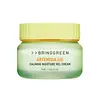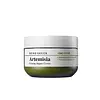What's inside
What's inside
 Key Ingredients
Key Ingredients

 Benefits
Benefits

 Concerns
Concerns

 Ingredients Side-by-side
Ingredients Side-by-side

Artemisia Capillaris Extract
Water
Skin ConditioningGlycerin
HumectantMethylpropanediol
Solvent1,2-Hexanediol
Skin ConditioningBetaine
HumectantVinyldimethicone
Isopropyl Palmitate
EmollientCaprylyl Methicone
Skin ConditioningHydrogenated Poly(C6-14 Olefin)
EmollientPhellodendron Amurense Bark Extract
Skin ConditioningHydrolyzed Gardenia Florida Extract
AntioxidantMacadamia Ternifolia Seed Oil
EmollientCitrus Aurantium Dulcis Peel Oil
MaskingSodium Hyaluronate
HumectantCymbopogon Martini Oil
MaskingOlea Europaea Fruit Oil
MaskingCananga Odorata Flower Oil
MaskingPelargonium Graveolens Flower Oil
MaskingCedrus Atlantica Bark Oil
MaskingFerula Galbaniflua Resin Oil
AntimicrobialRosa Damascena Flower Oil
MaskingPolymethylsilsesquioxane
Hydroxyethyl Acrylate/Sodium Acryloyldimethyl Taurate Copolymer
Emulsion StabilisingHydrogenated Polydecene
EmollientDimethiconol
EmollientAcrylates/C10-30 Alkyl Acrylate Crosspolymer
Emulsion StabilisingTromethamine
BufferingGlyceryl Acrylate/Acrylic Acid Copolymer
HumectantXanthan Gum
EmulsifyingCeramide NP
Skin ConditioningCandida Bombicola/Glucose/Methyl Rapeseedate Ferment
AntimicrobialPolyglyceryl-10 Stearate
Skin ConditioningSorbitan Isostearate
EmulsifyingDisodium EDTA
Cetearyl Alcohol
EmollientSodium Stearoyl Glutamate
CleansingMaltodextrin
AbsorbentEthylhexylglycerin
Skin ConditioningLimonene
PerfumingGeraniol
PerfumingArtemisia Capillaris Extract, Water, Glycerin, Methylpropanediol, 1,2-Hexanediol, Betaine, Vinyldimethicone, Isopropyl Palmitate, Caprylyl Methicone, Hydrogenated Poly(C6-14 Olefin), Phellodendron Amurense Bark Extract, Hydrolyzed Gardenia Florida Extract, Macadamia Ternifolia Seed Oil, Citrus Aurantium Dulcis Peel Oil, Sodium Hyaluronate, Cymbopogon Martini Oil, Olea Europaea Fruit Oil, Cananga Odorata Flower Oil, Pelargonium Graveolens Flower Oil, Cedrus Atlantica Bark Oil, Ferula Galbaniflua Resin Oil, Rosa Damascena Flower Oil, Polymethylsilsesquioxane, Hydroxyethyl Acrylate/Sodium Acryloyldimethyl Taurate Copolymer, Hydrogenated Polydecene, Dimethiconol, Acrylates/C10-30 Alkyl Acrylate Crosspolymer, Tromethamine, Glyceryl Acrylate/Acrylic Acid Copolymer, Xanthan Gum, Ceramide NP, Candida Bombicola/Glucose/Methyl Rapeseedate Ferment, Polyglyceryl-10 Stearate, Sorbitan Isostearate, Disodium EDTA, Cetearyl Alcohol, Sodium Stearoyl Glutamate, Maltodextrin, Ethylhexylglycerin, Limonene, Geraniol
Artemisia Capillaris Extract 54.59%
Glycerin
HumectantHydrogenated Poly(C6-14 Olefin)
EmollientDipropylene Glycol
HumectantButylene Glycol
HumectantTriethylhexanoin
MaskingWater
Skin ConditioningCaprylic/Capric Triglyceride
MaskingBehenyl Alcohol
EmollientNiacinamide
SmoothingCyclopentasiloxane
Emollient1,2-Hexanediol
Skin ConditioningGlyceryl Stearate
EmollientCyclohexasiloxane
EmollientVincetoxicum Atratum Extract
Skin ConditioningPoncirus Trifoliata Fruit Extract
Skin ConditioningMadecassoside
AntioxidantMadecassic Acid
Skin ConditioningAsiaticoside
AntioxidantAsiatic Acid
Skin ConditioningPortulaca Oleracea Extract
Skin ConditioningCentella Asiatica Extract
CleansingSpinacia Oleracea Leaf Extract
Skin ConditioningHibiscus Esculentus Fruit Extract
Skin ConditioningBrassica Oleracea Italica Extract
AstringentBrassica Oleracea Capitata Leaf Extract
Skin ConditioningArtemisia Princeps Leaf Water
MaskingPanthenol
Skin ConditioningAdenosine
Skin ConditioningCitrus Aurantium Bergamia Fruit Oil
MaskingSalvia Officinalis Oil
MaskingGeranium Maculatum Oil
MaskingPogostemon Cablin Leaf Oil
MaskingDipotassium Glycyrrhizate
HumectantHydrogenated Lecithin
EmulsifyingC12-16 Alcohols
EmollientPalmitic Acid
EmollientAmmonium Acryloyldimethyltaurate/Vp Copolymer
Hydroxyethyl Acrylate/Sodium Acryloyldimethyl Taurate Copolymer
Emulsion StabilisingPolyglyceryl-10 Laurate
Skin ConditioningMicrocrystalline Wax
Emulsion StabilisingDiphenyl Dimethicone
EmollientPolyglyceryl-10 Myristate
Skin ConditioningStearic Acid
CleansingSorbitan Stearate
EmulsifyingEthylhexylglycerin
Skin ConditioningSorbitan Isostearate
EmulsifyingDisodium EDTA
Citronellol
PerfumingGeraniol
PerfumingLimonene
PerfumingLinalool
PerfumingArtemisia Capillaris Extract 54.59%, Glycerin, Hydrogenated Poly(C6-14 Olefin), Dipropylene Glycol, Butylene Glycol, Triethylhexanoin, Water, Caprylic/Capric Triglyceride, Behenyl Alcohol, Niacinamide, Cyclopentasiloxane, 1,2-Hexanediol, Glyceryl Stearate, Cyclohexasiloxane, Vincetoxicum Atratum Extract, Poncirus Trifoliata Fruit Extract, Madecassoside, Madecassic Acid, Asiaticoside, Asiatic Acid, Portulaca Oleracea Extract, Centella Asiatica Extract, Spinacia Oleracea Leaf Extract, Hibiscus Esculentus Fruit Extract, Brassica Oleracea Italica Extract, Brassica Oleracea Capitata Leaf Extract, Artemisia Princeps Leaf Water, Panthenol, Adenosine, Citrus Aurantium Bergamia Fruit Oil, Salvia Officinalis Oil, Geranium Maculatum Oil, Pogostemon Cablin Leaf Oil, Dipotassium Glycyrrhizate, Hydrogenated Lecithin, C12-16 Alcohols, Palmitic Acid, Ammonium Acryloyldimethyltaurate/Vp Copolymer, Hydroxyethyl Acrylate/Sodium Acryloyldimethyl Taurate Copolymer, Polyglyceryl-10 Laurate, Microcrystalline Wax, Diphenyl Dimethicone, Polyglyceryl-10 Myristate, Stearic Acid, Sorbitan Stearate, Ethylhexylglycerin, Sorbitan Isostearate, Disodium EDTA, Citronellol, Geraniol, Limonene, Linalool
Ingredients Explained
These ingredients are found in both products.
Ingredients higher up in an ingredient list are typically present in a larger amount.
1,2-Hexanediol is a synthetic liquid and another multi-functional powerhouse.
It is a:
- Humectant, drawing moisture into the skin
- Emollient, helping to soften skin
- Solvent, dispersing and stabilizing formulas
- Preservative booster, enhancing the antimicrobial activity of other preservatives
This flowering plant is more commonly known as Capillary wormwood.
According to a manufacturer, the flowers of this plant are used for their anti-inflammation and moisturizing properties.
Disodium EDTA plays a role in making products more stable by aiding other preservatives.
It is a chelating agent, meaning it neutralizes metal ions that may be found in a product.
Disodium EDTA is a salt of edetic acid and is found to be safe in cosmetic ingredients.
Learn more about Disodium EDTAEthylhexylglycerin (we can't pronounce this either) is commonly used as a preservative and skin softener. It is derived from glyceryl.
You might see Ethylhexylglycerin often paired with other preservatives such as phenoxyethanol. Ethylhexylglycerin has been found to increase the effectiveness of these other preservatives.
Geraniol is used to add fragrance/parfum to a product. It is the main component of citronellol. It is a monoterpenoid and an alcohol.
Monoterpenes are naturally found in many parts of different plants.
Geraniol can be found in many essential oils including Rose Oil and Citronella Oil. The scent of Geraniol is often described as "rose-like". Many foods also contain Geraniol for fruit flavoring.
Geraniol can irritate the skin when exposed to air. However, irritation depends on the ability of geraniol to penetrate into the skin. In general, geraniol is not able to penetrate skin easily.
Geraniol is colorless and has low water-solubility. However, it is soluble in common organic solvents.
Like citronellol, it is a natural insect repellent.
2,6-Octadien-1-ol, 3,7-dimethyl-, (2E)-
Learn more about GeraniolGlycerin is already naturally found in your skin. It helps moisturize and protect your skin.
A study from 2016 found glycerin to be more effective as a humectant than AHAs and hyaluronic acid.
As a humectant, it helps the skin stay hydrated by pulling moisture to your skin. The low molecular weight of glycerin allows it to pull moisture into the deeper layers of your skin.
Hydrated skin improves your skin barrier; Your skin barrier helps protect against irritants and bacteria.
Glycerin has also been found to have antimicrobial and antiviral properties. Due to these properties, glycerin is often used in wound and burn treatments.
In cosmetics, glycerin is usually derived from plants such as soybean or palm. However, it can also be sourced from animals, such as tallow or animal fat.
This ingredient is organic, colorless, odorless, and non-toxic.
Glycerin is the name for this ingredient in American English. British English uses Glycerol/Glycerine.
Learn more about GlycerinWe don't have a description for Hydrogenated Poly(C6-14 Olefin) yet.
This is a synthetic polymer. It helps improve the texture of products by adding thickness and gel-like feel.
It is also an emulsifer, meaning it prevents ingredients such as oil and water from separating. It also helps evenly disperse other ingredients.
Limonene is a fragrance that adds scent and taste to a formulation.
It's found in the peel oil of citrus fruits and other plants such as lavender and eucalyptus. The scent of limonene is generally described as "sweet citrus".
Limonene acts as an antioxidant, meaning it helps neutralize free radicals.
When exposed to air, oxidized limonene may sensitize the skin. Because of this, limonene is often avoided by people with sensitive skin.
The term 'fragrance' is not regulated in many countries. In many cases, it is up to the brand to define this term. For instance, many brands choose to label themselves as "fragrance-free" because they are not using synthetic fragrances. However, their products may still contain ingredients such as essential oils that are considered a fragrance.
Learn more about LimoneneSorbitan Isostearate is an emulsifer and cleaning agent. It is created from isostearic acid and sorbitol.
As an emulsifier, Sorbitan Isostearate prevents oils and water from separating.
Due to its isostearic acid base, it may not be safe for Malassezia or fungal acne.
Learn more about Sorbitan IsostearateWater. It's the most common cosmetic ingredient of all. You'll usually see it at the top of ingredient lists, meaning that it makes up the largest part of the product.
So why is it so popular? Water most often acts as a solvent - this means that it helps dissolve other ingredients into the formulation.
You'll also recognize water as that liquid we all need to stay alive. If you see this, drink a glass of water. Stay hydrated!
Learn more about Water